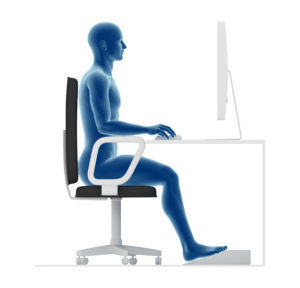
What is Ergonomics?
The word ‘ergonomics’ comes from the Greek words ‘ergon’ which means work, and ‘nomos’ which means natural laws. Ergonomics can thus can be defined simply as the natural laws of work. More specifically, ergonomics is the scientific study of designing the job and workplace to fit the worker, keeping in mind their capabilities and limitations. Ergonomics combines the knowledge from other scientific disciplines like anatomy and physiology, biomechanics, engineering, psychology, and statistics to ensure that workplace designs complement the strengths of people and minimize the effects of their limitations.
Ergonomics is also known as human factors, and the terms are often used interchangeably. Ergonomists and human factors specialists seek to understand how a workplace, product, tool, or system can be best designed to fit the people who need to use it. The goal is to apply this knowledge to improve system and human performance, productivity, while also focusing on the health, safety, and well-being of the individuals involved.
Why is Ergonomics Important?
Think about how many hours each day you spend sitting. If you work in an office setting, you are likely sitting more than most people.
According to Occupational Safety and Health Administration (OSHA) statistics, on average, 95% of an office worker’s day is spent sitting in front of the computer. Sitting in front of a computer all day for work is a relatively new concept that has become more common over the past two decades. Consequently, the adverse health effects associated with prolonged sitting have become more prevalent and are exacerbated when working at a computer. This is often due to poorly designed computer workstations and the physical stress that it places on joints, muscles, tendons, and nerves of the body.
However, most of us don’t realize the harmful effects of prolonged computer use until many years later. This is because the harmful effects of using poorly designed computer workstations are NOT immediate, and the discomfort we initially feel is very mild, thus we tend to ignore them.
We later assume our neck aches, back pain, headaches, and poor posture are due to getting older and “our own fault” for not exercising enough and being lazy. We fail to realize that our workstation is harming us and putting physical stress on our bodies which can eventually lead to musculoskeletal disorders.
What Are Musculoskeletal Disorders?
Musculoskeletal disorders (MSDs) are injuries of the soft tissues (muscles, tendons, ligaments, and joints) and nervous system. Work-related MSDs affect nearly all tissues and areas of the body, though the most frequently affected are the arms and back. These disorders have a variety of names, including cumulative trauma disorders (CTDs) and repetitive strain injuries (RSIs). These disorders include carpal tunnel syndrome, tendonitis, tenosynovitis, thoracic outlet syndrome, neck and low back pain, sciatica, and strain/sprain injuries.
What Causes Work-Related MSDs?
MSDs arise from risk factors, or physical stressors, that would not typically result in undue stress or harm if only performed once. That is why MSDs typically develop gradually over weeks, months, and years. MSD risk factors include force, repetition, awkward postures, static postures, quick motions, compression or contact stress, vibration, and cold temperatures. The most common risk factors among office workers are repetitive motions that can irritate tendons and increase pressure on nerves (long hours of typing or using a mouse), poor body mechanics and awkward postures (slouching in an office chair or holding a telephone to your ear with your shoulder), and prolonged static posture with inadequate recovery time that can constrict blood flow and damage muscles (intensive hours at the keyboard with few breaks). All of these risk factors, either alone or in combination, can cause or exacerbate MSDs when present for a sufficient duration, frequency, or magnitude.
The High Cost of MSDs
OSHA has identified that Work-Related MSDs are the single largest job-related injury and illness problem in the US and account for 34% of all reported lost workday illnesses and injuries, with over 600,000 MSDs requiring time away from work every year. Carpal tunnel syndrome is the single most common injury in the workplace, accounting for 15% of all workplace injuries, and 42% of carpal tunnel syndrome cases result in more than 30 days away from work.
MSDs now account for 1 out of every 3 dollars spent on workers compensation and employers spend $15-$20 billion a year on direct costs for MSD-related workers’ compensation, and up to five times that much for indirect costs.
Why YOU should care about Ergonomics?
As already stated, the harmful effects related to sitting in front of a computer all day often go unnoticed until many years later. Most of the Work-Related MSDs take time to develop, and when they do, they can take a lot of time and money to treat properly.
As with most things, prevention is better than a cure. However, the problem with not understanding proper workstation ergonomics, is that you do not know what to look for. Do you notice the strain or tension in your muscles?
Do you notice how you have been sitting with a slumped posture and forward head? You might simply attribute that achy discomfort to getting older. The truth is, our bodies are not designed to sit in constricted positions staring at a computer screen all day. Thus we slouch, push our heads forward, and look closely at the screen simply because it feels more comfortable that way. We are able to deal with it from day to day. Until we can’t. What was once a strain or mild ache is now pain and it can lead to huge medical bills.
By learning and applying proper ergonomics, you will minimize the risks associated with prolonged sitting at a computer workstation all day and reduce your chances of developing repetitive strain injuries, and reduce future medical expenses. In addition to better health, you will also become more effective and productive, and find working a more enjoyable experience.



